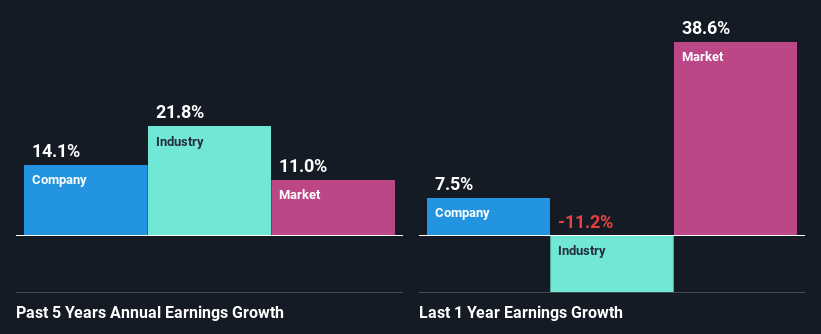Do Its Financials Have Any Role To Play In Driving Data#3 Limited's (ASX:DTL) Stock Up Recently?
Data#3 (ASX:DTL) has had a great run on the share market with its stock up by a significant 20% over the last three months. Given that stock prices are usually aligned with a company's financial performance in the long-term, we decided to study its financial indicators more closely to see if they had a hand to play in the recent price move. Particularly, we will be paying attention to Data#3's ROE today.
Return on Equity or ROE is a test of how effectively a company is growing its value and managing investors’ money. In short, ROE shows the profit each dollar generates with respect to its shareholder investments.
See our latest analysis for Data#3
How Do You Calculate Return On Equity?
ROE can be calculated by using the formula:
Return on Equity = Net Profit (from continuing operations) ÷ Shareholders' Equity
So, based on the above formula, the ROE for Data#3 is:
45% = AU$25m ÷ AU$56m (Based on the trailing twelve months to June 2021).
The 'return' is the income the business earned over the last year. That means that for every A$1 worth of shareholders' equity, the company generated A$0.45 in profit.
Why Is ROE Important For Earnings Growth?
So far, we've learned that ROE is a measure of a company's profitability. Based on how much of its profits the company chooses to reinvest or "retain", we are then able to evaluate a company's future ability to generate profits. Generally speaking, other things being equal, firms with a high return on equity and profit retention, have a higher growth rate than firms that don’t share these attributes.
Data#3's Earnings Growth And 45% ROE
Firstly, we acknowledge that Data#3 has a significantly high ROE. Second, a comparison with the average ROE reported by the industry of 8.3% also doesn't go unnoticed by us. This likely paved the way for the modest 14% net income growth seen by Data#3 over the past five years. growth
As a next step, we compared Data#3's net income growth with the industry and were disappointed to see that the company's growth is lower than the industry average growth of 22% in the same period.
The basis for attaching value to a company is, to a great extent, tied to its earnings growth. The investor should try to establish if the expected growth or decline in earnings, whichever the case may be, is priced in. By doing so, they will have an idea if the stock is headed into clear blue waters or if swampy waters await. Has the market priced in the future outlook for DTL? You can find out in our latest intrinsic value infographic research report.
Is Data#3 Making Efficient Use Of Its Profits?
Data#3 has a significant three-year median payout ratio of 91%, meaning that it is left with only 9.4% to reinvest into its business. This implies that the company has been able to achieve decent earnings growth despite returning most of its profits to shareholders.
Additionally, Data#3 has paid dividends over a period of at least ten years which means that the company is pretty serious about sharing its profits with shareholders. Our latest analyst data shows that the future payout ratio of the company over the next three years is expected to be approximately 91%. Therefore, the company's future ROE is also not expected to change by much with analysts predicting an ROE of 49%.
Summary
Overall, we feel that Data#3 certainly does have some positive factors to consider. The company has grown its earnings moderately as a result of its impressive ROE. Yet, the business is retaining hardly any of its profits. This might have negative implications on the company's future growth. On studying current analyst estimates, we found that analysts expect the company to continue its recent growth streak. Are these analysts expectations based on the broad expectations for the industry, or on the company's fundamentals? Click here to be taken to our analyst's forecasts page for the company.
Have feedback on this article? Concerned about the content? Get in touch with us directly. Alternatively, email editorial-team (at) simplywallst.com.
This article by Simply Wall St is general in nature. We provide commentary based on historical data and analyst forecasts only using an unbiased methodology and our articles are not intended to be financial advice. It does not constitute a recommendation to buy or sell any stock, and does not take account of your objectives, or your financial situation. We aim to bring you long-term focused analysis driven by fundamental data. Note that our analysis may not factor in the latest price-sensitive company announcements or qualitative material. Simply Wall St has no position in any stocks mentioned.

